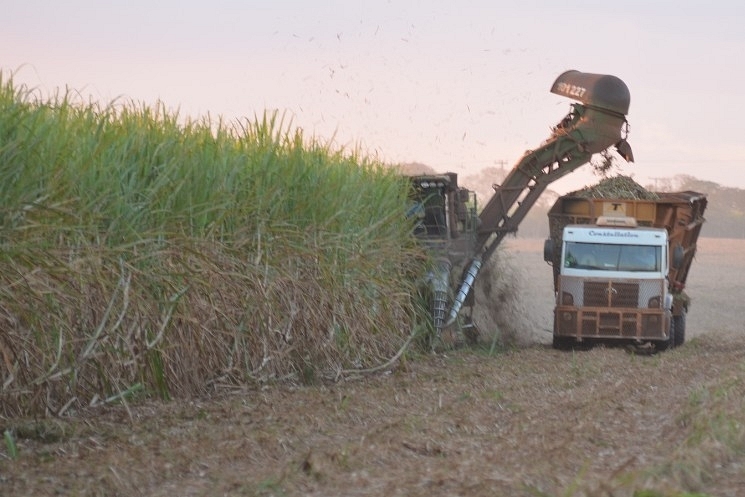Economy
Timing It Sweet: Export Incentives For Sugar Industry Couldn’t Have Been Timed Better
- With sugar exports looking up, the Modi government has one thing less to be worried about.
- It could give the BJP some leeway in western Uttar Pradesh and Maharashtra, the two big sugar producers in the country.

Sugarcane being cut at a farm in Ribeirao Preto, northeast of Sao Paula in Brazil. (M R Subramani)
One is not sure what the central government had in mind when the Union cabinet cleared a slew of incentives to boost sugar exports on 26 September this year. But the timing was just perfect, despite some sceptics trying to run it down. Since the decision, a series of sweet news has followed, much to the happiness of the Indian sugar industry. Had any stock market player invested in a sugar stock a month ago, he would have made a profit by now notwithstanding an erratic Sensex.
In order to inject the much-required liquidity in sugar mills, the Centre decided to give sugar mills a transport subsidy ranging between Rs 1,000 and Rs 3,000 based on their distance from the ports. The cabinet also cleared the proposal to pay an additional Rs 138.80 a tonne for crushed cane to farmers. The measures will cost the government over Rs 5,500 crore.
The government’s announcement was welcomed with scepticism with one commentator saying the export option for Indian sugar mills may not be attractive. But what the detractors did not take into account was the emerging global scenario, particularly in Brazil.
On 3 October, the US Department of Agriculture Foreign Agricultural Service reported that dry weather had cut into sugarcane production in Brazil to 610 million tonnes (mt) this marketing year (April 2018-March 2019), down from 639 mt last year. Of this, 37.5 per cent of the crop is estimated to be diverted for sugar, while the rest will be sent for producing ethanol. In Brazil, growers decide on whether to send their cane for crushing or ethanol production based on sugar prices in the market. It makes sense for the growers to allocate more for ethanol because the global crude oil market is looking up following uncertainties over Iran crude oil availability.
This will likely see Brazil raw sugar exports dropping to 19.6 mt – 15.6 mt raw sugar and 3.92 mt refined. The is the lowest in the last 11 years, though the drop will help boost ending stocks by 1.25 mt. What this has resulted in is that raw sugar prices in the global futures market have galloped to a seven-month high. The news of a lower Brazilian production and diversion for sugar has been a happy augury for Indian sugar mills. The very same day, Indian sugar companies’ stocks jumped higher. In the domestic market, prices in Mumbai wholesale market have now touched Rs 31 a kg.
The most important aspect of this whole development is that India will resume raw sugar exports after three years. No doubt, in the crop year that ended 30 September, sugar exports were way off target at 4.5 lakh tonnes as mills were reluctant to sign new contracts in view of lower global prices.
The Brazilian lower production and sugar export forecast has changed the scenario totally. Over the last week or so, mills have signed to export at least 1.5 lakh tonnes of raw sugar at $280 (Rs 20,850 approximately) a tonne free-on-board (FOB). Another 1 lakh tonne of refined sugar has been contracted for exports to the Gulf and north Africa at $305 (Rs 22,700) a tonne FOB before December. Reuters reported that more shipments from India could be in store replacing Brazil and Thailand share in the global market.
A fall in the rupee value has made exports competitive. With production estimated at 350 lakh tonnes and a carryover of 100 lakh tonnes, India carries surplus stocks of refined sugar. This will now encourage mills to just produce raw sugar and look for export opportunities. With Australian sugarcane production, too, suffering from drought, India could target the South-East and Far-East countries like Korea, Indonesia or Malaysia to ship raw sugar.
The sugar trade expects at least 40 lakh tonnes of exports with raw sugar making up at least 60 per cent of it. Taking into consideration domestic consumption of 250 lakh tonnes, India would still have a lot to spare for the export market. Going into elections scheduled next year, the Narendra Modi government has one thing less to be worried about. It could give the Bharatiya Janata Party some leeway in western Uttar Pradesh and Maharashtra, the two big sugar producers in the country.
Introducing ElectionsHQ + 50 Ground Reports Project
The 2024 elections might seem easy to guess, but there are some important questions that shouldn't be missed.
Do freebies still sway voters? Do people prioritise infrastructure when voting? How will Punjab vote?
The answers to these questions provide great insights into where we, as a country, are headed in the years to come.
Swarajya is starting a project with an aim to do 50 solid ground stories and a smart commentary service on WhatsApp, a one-of-a-kind. We'd love your support during this election season.
Click below to contribute.
Latest